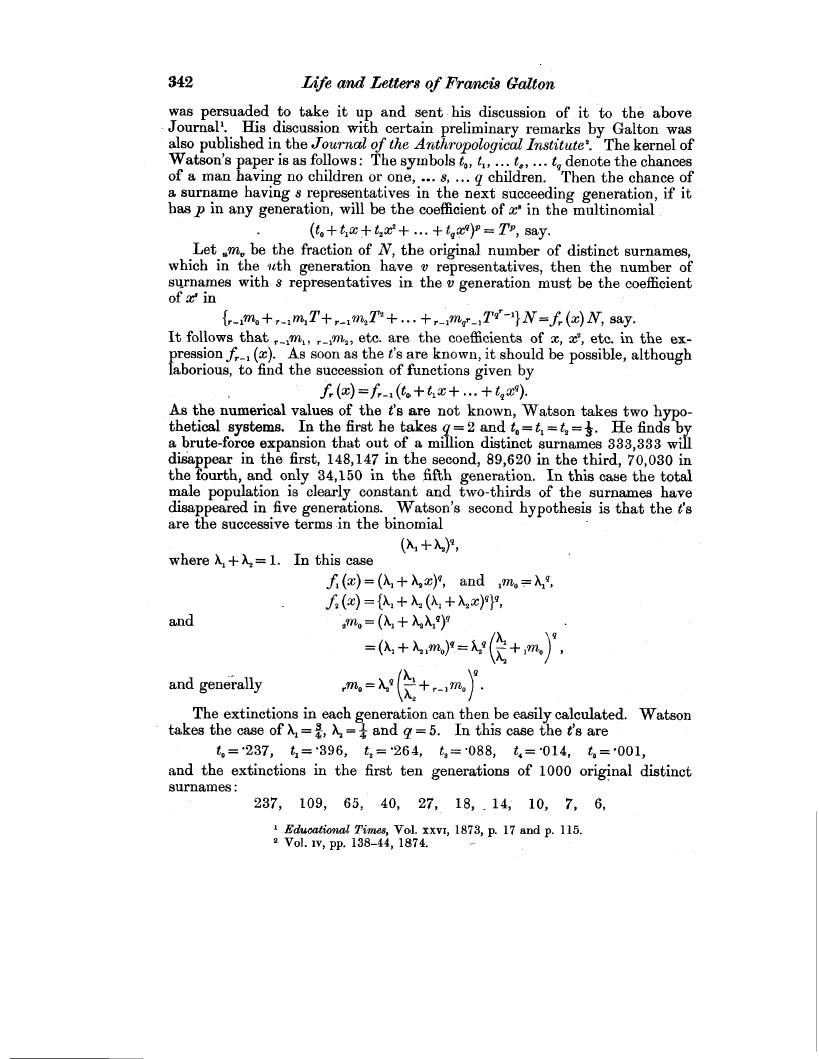342 Life and Letters of Francis Galton
was persuaded to take it up and sent his discussion of it to the above Journal'. His discussion with certain preliminary remarks by Galton was also published in the Journal of the Anthropological Institute'. The kernel of Watson's paper is as follows: The symbols to, t„ ... t„ ... tg denote the chances of a man having no children or one, ... s, ... q children. Then the chance of a surname having s representatives in the next succeeding generation, if it has p in any generation, will be the coefficient of x8 in the multinomial .
(to + tlx + t,x2 + ... + tgxq)v = Tp, say.
Let um„ be the fraction of N, the original number of distinct surnames, which in the uth generation have v representatives, then the number of surnames with s representatives in the v generation must be the coefficient of x' in
{r_,m0+,._1m,T-+-,._im2T2+...'+r_,mgr_iTgr-'}N=fr(x)N, say.
It follows that -,m,,_,m,, etc. are the coefficients of x, x2, etc. in the ex
pression fr_, (x). As soon as the is are known, it should be possible, although
laborious, to find the succession of functions given by
fr (x) =f-, (to + t,x + ... + tgxg).
As the numerical values of the is are not known, Watson takes two hypothetical systems. In the first he takes q = 2 and to = t, = t2 = *. He finds by a brute-force expansion that out of a million distinct surnames 333,333 will disappear in the first, 148,147 in the second, 89,620 in the third, 70,030 in the fourth, and only 34,150 in the fifth generation. In this case the total male population is clearly constant and two-thirds of the surnames have disappeared in five generations. Watson's second hypothesis is that the is are the successive terms in the binomial
(Al +x.)% ,
where A, + A2 =1. In this case
f (x) = (A, + A2 x)g, and ,m,, = A,g,
f2 (x) _ {A, + A2 (A' + X,x)g}g,
and 2mo + A2A,g)g
g
_ (X, + ,mo)g = g (Xi
+ ,mo ,
4
and generally ,.m0 (+rimo) z
The extinctions in each generation can then be easily calculated. Watson takes the case of A, _ 1, k = 4 and q = 5. In this case the is are
to=•237, t,='396, t2=•264, t,=•088, t,='014, to=•001,
and the extinctions in the first ten generations of 1000 original distinct surnames
237, 109, 65, 40, 27, 18, _ 14, 10, 7, 6,
' Educational Times, Vol. xxvi, 1873, p. 17 and p. 115. 2 Vol. iv, pp. 138-44, 1874. --

